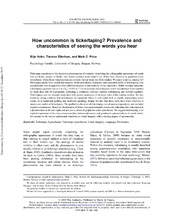| dc.contributor.author | Holm, Silje | |
| dc.contributor.author | Eilertsen, Thomas | |
| dc.contributor.author | Price, Mark | |
| dc.date.accessioned | 2016-01-05T09:50:20Z | |
| dc.date.available | 2016-01-05T09:50:20Z | |
| dc.date.issued | 2015-06-17 | |
| dc.Published | Cognitive Neuroscience 2015, 6(2-3):89-99 | eng |
| dc.identifier.issn | 1758-8936 | |
| dc.identifier.uri | https://hdl.handle.net/1956/10864 | |
| dc.description.abstract | Tickertape experience is the subjective phenomenon of routinely visualizing the orthographic appearance of words that one hears, speaks, or thinks, like mental subtitles in the mind’s eye. It has been observed in grapheme-color synesthetes, whose letter visualizations are colored, but has been very little studied. We report a survey, among 425 Norwegian adults from varied sub-samples, of the prevalence, character, and associated skills of tickertaping. Our questionnaire was designed to reflect different degrees of automaticity of the experience. While strongly automatic tickertaping appeared rare (n = 6; CI95 = 0.6% to 3.2% of sample), lesser degrees of text visualization were reported by more than half of respondents, indicating a continuity between extreme tickertaping and normal cognition. Tickertaping was not strongly associated with greater awareness of an inner voice while reading silently. We also found no strong evidence that tickertapers are unusually likely to self-report skill in rapidly enumerating heard words, or in backward spelling and backward speaking, despite the fact that these skills have been observed in single-case studies of tickertapers. The qualitative character of tickertaping varied among respondents, and included negative experiences. However visualization of letters was predominantly uncolored, indicating that tickertaping is a phenomenon in its own right and not just a subset of grapheme-color synesthesia. We suggest tickertaping is an explicit expression of the close interconnection between phonemic and graphemic representations of words which, for reasons we do not yet understand, manifests as visual imagery with a varying degree of automaticity. | en_US |
| dc.language.iso | eng | eng |
| dc.publisher | Taylor & Francis | eng |
| dc.rights | Attribution CC BY | eng |
| dc.rights.uri | http://creativecommons.org/licenses/by-nc-nd/4.0 | eng |
| dc.subject | Synesthesia | eng |
| dc.subject | Tickertape synesthesia | eng |
| dc.title | How uncommon is tickertaping? Prevalence and characteristics of seeing the words you hear. | eng |
| dc.type | Peer reviewed | |
| dc.type | Journal article | |
| dc.date.updated | 2015-12-22T10:31:10Z | |
| dc.description.version | publishedVersion | |
| dc.rights.holder | Copyright 2015 The Author(s) | eng |
| dc.identifier.doi | https://doi.org/10.1080/17588928.2015.1048209 | |
| dc.identifier.cristin | 1247949 | |
| dc.subject.nsi | VDP::Medisinske Fag: 700 | |
| dc.subject.nsi | VDP::Samfunnsvitenskap: 200::Psykologi: 260::Biologisk psykologi: 261 | |
| dc.subject.nsi | VDP::Social sciences: 200::Psychology: 260::Biological psychology: 261 | |
| dc.subject.nsi | VDP::Samfunnsvitenskap: 200::Psykologi: 260::Kognitiv psykologi: 267 | |
| dc.subject.nsi | VDP::Social sciences: 200::Psychology: 260::Cognitive psychology: 267 | |

